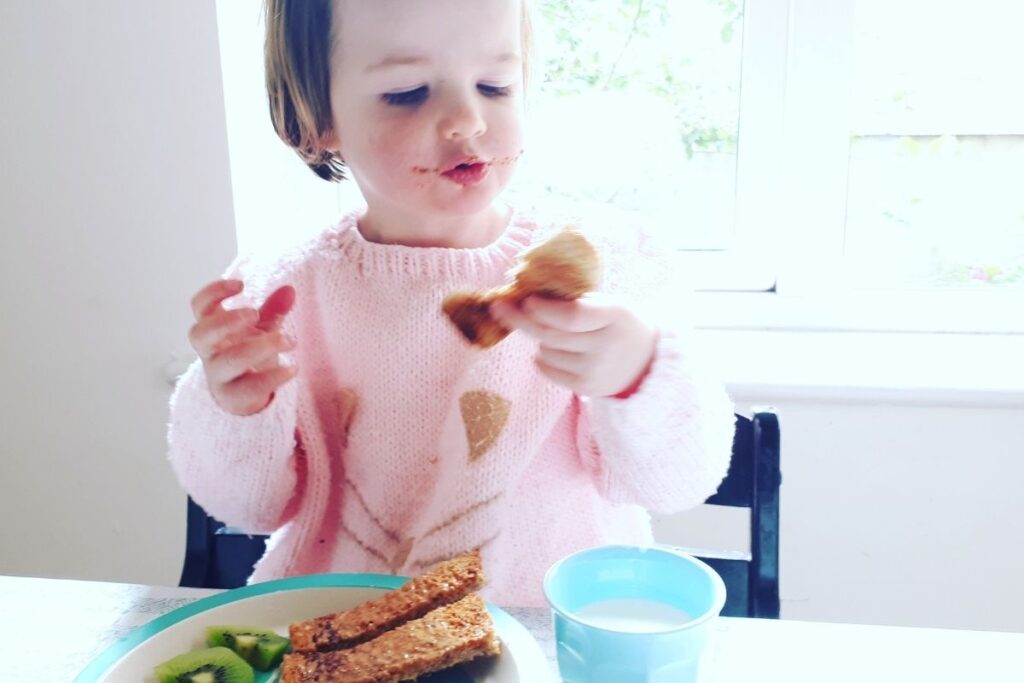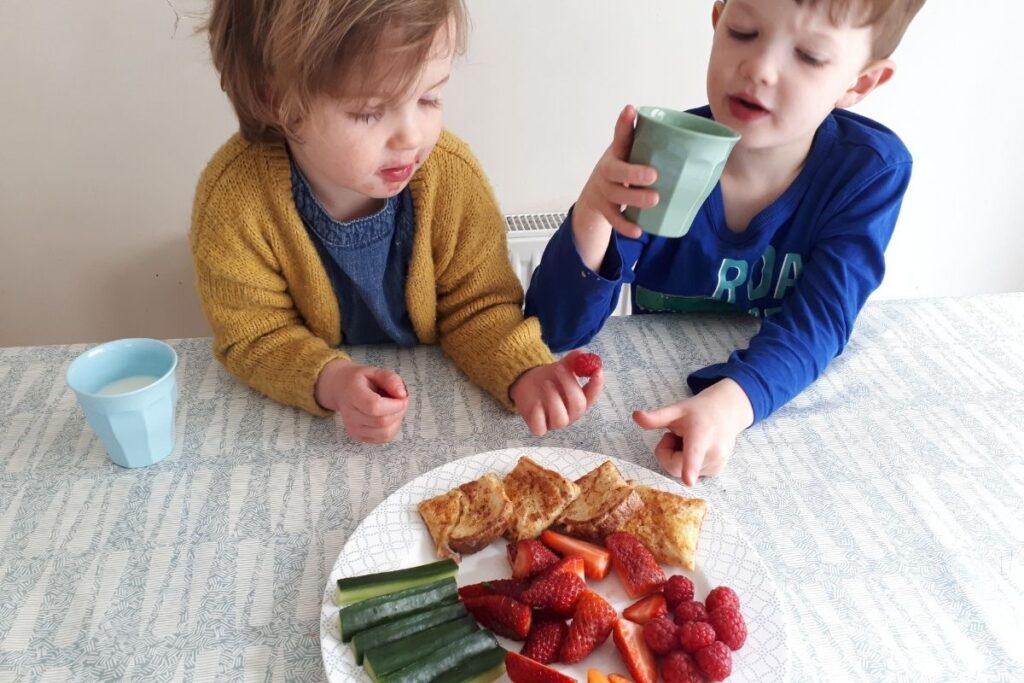Do you ever feel like a vending machine? Just doling out snacks all day long! This is how many parents tell me they feel. And believe me, I understand, my kids would snack all day too if allowed.
What’s the difference between structured snacks and ‘grazing’?
Firstly, let’s look at the difference between ‘grazing’ or the proverbial vending machine and what we mean by sit-down or structured snacks. And why structured snacks trump grazing every time.
Structured snacks are a helpful feeding strategy
WHEN: At predictable times between meals. Probably morning, afternoon and maybe bedtime. Not too close to mealtimes.
WHERE: Mostly at the table.
WHAT: Varied mini-meals with 2-3 foods of YOUR choice. This fills gaps in your child’s nutrition and exposes them to new foods and foods they don’t like yet.

This is my four-year-old, Alice enjoying an after school snack!
Grazing is an unhelpful feeding strategy
WHEN: ALL the time. Can be right before a meal is due or straight after a meal
WHERE: In the kitchen, the sitting room, the car, the playroom, walking around the house, garden, bedroom, directly from the cupboard………
WHAT: Usually favourite foods and easy snack options that kids love. Lots of half-eaten and discarded food!
Why are snacks important for your toddler (or pre-schooler)?
- Small kids have small tummies, so eating little and often makes sense.
- They need a wide range of nutrients during the day. The more meals they have, the higher the chance they get what they need.
- Regular snacks provide security, predictability and structure. And kids thrive on this. Ever wondered why kids eat better in créche?!
And here’s Alice again as a toddler!
How can snacks help you?
- They stop you freaking out if your child skips a meal.
- They offer you more chances to provide variety.
- They save your sanity because you get to clock off from kitchen duty.
- They help you stay in charge of ‘what’ foods are offered.
- They add structure to your day too.
A helpful snack strategy
Having a clear strategy about snacking in your house will help you encourage positive eating habits and save your sanity. Believe me, you need this!
You are in charge of WHEN snacks are served
Try to set up a predictable schedule (but flexible) during the day.
As a general rule of thumb:
- Toddlers need to eat 5-6 times per day.
- Pre-schoolers need to eat 5 times a day
- School-aged children need to eat 4-5 times per day
In between those times, the kitchen is closed! Put a sign on the door if you need to.
You are in charge of WHERE snacks are served
The best place to have snacks is at the kitchen table (if you have one) or in the kitchen somewhere. Picnics or eating outside is fine too. But it’s not as helpful to eat in front of the TV, while playing or in the car. As well as being messy, it encourages mindless eating, and for younger children, it’s a choking risk.
You are in charge of WHAT snacks are served
Try to break down the distinction between ‘snack’ foods and ‘meal foods’.
When you hear the word “snack,” what comes to mind?

Sometimes it’s hard to think beyond Liga, baby rice cakes and Organix carrot sticks. And whilst these are fine occasionally they are more sometimes foods than everyday snacks.
Words like ‘fruit-sweetened’, ‘organic’ and ‘natural’ often imply that packaged kids snacks are good choices. But, that box of healthy, natural, organic gingerbread men contains just, well, biscuits. Often containing similar amounts of sugar and calories as many other biscuits, despite the health claims.
Don’t get me wrong there’s room for sugary foods in everyone’s lives. But if every snack for your child is actually packaged sweetened snack, it can set them up for unhealthy eating habits in the future.
Children have smaller tummies than adults
So its important that snacks between meals are full of energy and nutrients. A “snack” is really a mini-meal, made up of real foods like chopped fruit and vegetables, wholegrains, dairy (cheese and yoghurt) and protein (cold meat, hummus and nuts). These foods are full of important nutrients that little bodies require to grow and develop.
When children mostly eat packaged snacks instead they don’t get the energy they need to concentrate and thrive. These foods don’t tend to provide the nutrients that kids need and leave less room for more nutritious food.
So, when planning a snack including a fruit and/or vegetable is always always a good place to start and then add at least one other food. This offers variety, gives a more filling snack and takes the pressure off mealtimes because you’re serving nutritious foods throughout the day and not reserving them for ‘big meals’.
You’ll also find a week of snacks here in this blog.
Make life easy for yourself!
With four kids I’m a fan of easy snacks. Our snacks typically involve grabbing three foods and piling them on a large plate, chopping board or serving plate for the kids to share. Whatever they don’t eat, I eat. And I save time by having easy staples like crackers, oatcakes, breadsticks, dried fruit, nut spreads in a box in the cupboard, the rest I grab from the fruit bowl or fridge.
My kids love sharing plates- they don’t need to like EVERY food on the plate
Your child is in charge of WHETHER TO EAT and HOW MUCH
Try to include one thing on the plate that your child eats most of the time. The other food could be one you’re hoping that they’ll learn to like someday. Then allow your child to eat as much as they like at snack times from the foods on offer. Sometimes my lot will come back for second or third helpings. This often means that the snack might be bigger than lunch, but so what?! If the foods are similar it really doesn’t matter. And it’s important for children to learn to tune in their own feelings of hunger and fullness.

Questions you commonly ask me about baby and toddler snacks?
What if my child raids the fridge or cupboards?
- Depending on the age of your child have a chat about your new snack system. Explain that you’ll be having a snack in the morning and another in the afternoon. Between those times the kitchen is closed. Make a visual timetable if your child is younger.
- Get your child involved in picking some snack ideas.
- For smaller children, it can be easier to use cupboard locks and put snacks out of reach.
- If you’re consistent your child will quickly adapt to the new routine
What if my child is crying for a snack at another time?
Acknowledge their feelings ‘I know you’re hungry, we’ll be having our dinner soon (say the time if they’re old enough to understand), why don’t we get out your colouring and when you’ve finished it’ll be dinner time’. Bring the snack forward a little if you need to.
Or
‘ We just had lunch, maybe you’re hungry because you didn’t eat enough. Don’t worry; we have a snack coming up soon, let’s go outside and play on the swings’.
If you’re consistent they will eventually get into the rhythm of your routine. After all, this is what happens at créche and school!

When should I introduce snacks to my baby?
You’ll find advice differs on this. In Ireland, HSE resources recommend snacks from as early as 6-9 months while in the UK, snacks are recommended after 12 months when milk intake decreases. Personally, I’m with the UK on this one! It’s difficult enough to fit in three meals, milk and naps into a 12-hour day. Trying to squeeze in 2-3 snacks on top means non-stop feeding and could mean that your baby isn’t hungry enough at mealtimes. So, you’ll have to make up your own mind on this one. However, whatever you decide choose regular foods rather than relying too much on shop-bought baby snack options. These fill your baby but don’t offer much in the way of nutrients or helpful learning experiences.
LEARN MORE: Sugar for babies-Separating fact from fiction!
What about my snacking?
While we don’t need to eat as often as our kids. Snacks are still a useful way of bumping up our fruit and vegetable intake too! So feel free to join your kids at the table.
Where do chocolate biscuits fit in?
Any food can fit as part of a snack, depending on the age of your children. Serving chocolate, biscuits and other sweet foods at meal and snack times alongside other foods is something I think works better than at random times. This approach takes sweets off their pedestal and reduces their power. Whether you include these foods and how often will depend on the age of your children and also on how often you would like them to eat these foods.
Learn more about HOW and WHAT to feed children aged 1-5 years by enrolling on my Feeding Your Toddler online course.










0 Comments